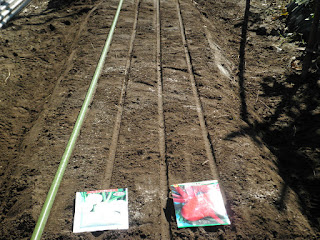🍃December January February
Winters months are a kind of go-slow gardening! You worked hard from early spring to late summer growing and harvesting all kinds of veggie. In fall you planted broccoli, cabbages, cauliflowers, lettuce, beans, peas, onions, and other that should get you through the winter months. Before laid back, enjoy eating fresh produce, you may want to grow some frost-tolerant leafy veggie -- spinach, pak choi, choy sum, komatsuna, red-green leaf lettuces, mustard greens, chard, turnip, red radish, and kale -- to add fresh color to your salad plates, home-cooked soup, and stew in winter months. So get your green thumb on and sow your last seeds (preferably every two weeks throughout October and November) before it gets too cold out there!
Grow Leafy vegetable:
Prepare seed beds as described in Spring Veggie. Don`t mix fertilizers too deep. Unlike summer veggie leafy veggie don't put down their roots deep. Their food (nutrients) need to be near the surface of the beds where they can reach them easily.
To sow seeds in a row, lightly press a long stick horizontally (or vertically) every 20 cm apart and make concave lines on the seedbed (see picture). Sow seeds in the concave, and gently cover the seed with your thumb and index finger. Water gently, and make sure to keep the seedbed wet until the seeds germinate. Like many other plants, most leafy vegetables remain dormant and don`t need much feeding and watering during winter months.
To sow seeds in a row, lightly press a long stick horizontally (or vertically) every 20 cm apart and make concave lines on the seedbed (see picture). Sow seeds in the concave, and gently cover the seed with your thumb and index finger. Water gently, and make sure to keep the seedbed wet until the seeds germinate. Like many other plants, most leafy vegetables remain dormant and don`t need much feeding and watering during winter months.
My experience is, protecting vegetable plants from cold and wind is more important than adding additional ones in winter gardens.
 Pak Choi, a small dark green flower-like easy to grow wintergreen
Pak Choi, a small dark green flower-like easy to grow wintergreen
with white stems. Sprinkle seeds in bed when the temperature remains warm. Pak Choi is robust, not prone to diseases. Thin seedlings, or carefully dig up some (when they are about 5 cm.) and transplant them to their new beds. Pak Choi mature in as little as six weeks. Net to protect them from butterflies and grasshoppers. As the name said, Pak Cho, make excellent Chinese dishes. Stir- fry it with meat and fish.


Grow Spinach:
Spinach does well in a mild climate. You can grow spinach in spring and in fall. Select the kinds you like and want to grow.
Make raise bed slightly acidic by sprinkling limestone.
You can sprinkle seeds evenly, or sow seeds in bed in rows as described above. It`s good to sow more seeds than you need and thin them later as plants grow big.
Problem with spinach is, many seeds will not germinate in beds that get dry soon. Keep seedbeds wet and warm until most seeds germinate. Bugs, special ants will take spinach seeds in their burrows for winter feeds. Cutworms destroy many young plants by cutting their stems.
To ensure better germination, tie spinach seeds inside a cotton cloth and soak it overnight. Shake off excess water, put the seed-sack inside a plastic bag and refrigerate for five to seven days. When the seeds germinate (look for emerging white roots), sow spinach seeds outdoors. (see picture)
Problem with spinach is, many seeds will not germinate in beds that get dry soon. Keep seedbeds wet and warm until most seeds germinate. Bugs, special ants will take spinach seeds in their burrows for winter feeds. Cutworms destroy many young plants by cutting their stems.
To ensure better germination, tie spinach seeds inside a cotton cloth and soak it overnight. Shake off excess water, put the seed-sack inside a plastic bag and refrigerate for five to seven days. When the seeds germinate (look for emerging white roots), sow spinach seeds outdoors. (see picture)
Grow Pak Choi:
 Pak Choi, a small dark green flower-like easy to grow wintergreen
Pak Choi, a small dark green flower-like easy to grow wintergreen with white stems. Sprinkle seeds in bed when the temperature remains warm. Pak Choi is robust, not prone to diseases. Thin seedlings, or carefully dig up some (when they are about 5 cm.) and transplant them to their new beds. Pak Choi mature in as little as six weeks. Net to protect them from butterflies and grasshoppers. As the name said, Pak Cho, make excellent Chinese dishes. Stir- fry it with meat and fish.
Grow Reds, greens mustard:

Mustard greens:
Assorted Greens:

Winter protection:
Portable winter covers:
Portable winter covers:













No comments:
Post a Comment